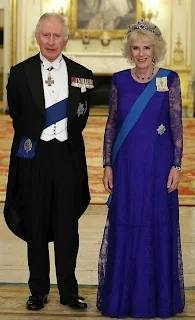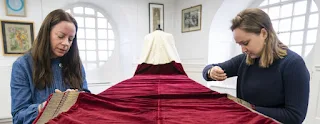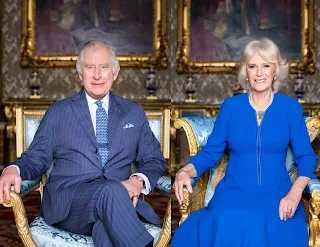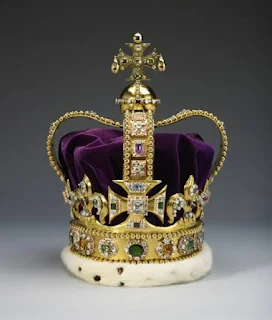It's five days more to go before the historic Coronation Ceremony of King Charles III and Queen Camilla, here, we will give you details of what fabrics Their Majesties will wear on that significant day in British history.
There was never quite as splendid as the British Sovereign's Coronation in the royal pageantry so expect a jaw-dropping royal spectacle this coming weekend. And the Coronation Robes will surely be one of the centers of attraction.
 |
| King Charles III and Queen Camilla ©The Royal Family |
In the past Coronation of the British monarch, the Coronation Robes have a distinct role during the six-part ceremony which consist of the recognition, the oath, the anointing (also referred to as the hallowing), the investiture (which includes the moment of crowning), the enthronement, and the homage.
In keeping with His Majesty's principle of sustainability, he will re-wear his grandfather's, King George VI, Coronation Robes with some additional elements sewn on the fabrics.
 |
| Queen Elizabeth II and Prince Philip during the Coronation in 1953 ©Royal Collection Trust |
As the monarch enters Westminster Abbey, the Sovereign wears the Robe of State, which also refers to as the Parliament Robe. The long crimson velvet train on the Robe of State is adorned with handmade delicate gold lace, lined in regal ermine from Canada, and has an accompanying ermine cape.
During the part of the ceremony known as the anointing, the monarch will be divested of all celebrated symbols of status, and wears the Colobium Sindonis (Latin for ‘Shroud Tunic’).
 |
| Coronation portrait of King George VI with his wife, Queen Elizabeth, and daughters Princesses Elizabeth and Margaret. May 1937 ©Royal Collection Trust |
In stark contrast to the Robe of State, this gown is austere and plain, without detail or lace. In its simplicity, this robe symbolizes divesting oneself of all worldly vanity, to stand bare before God.
During the investiture and worn over the Colobium Sindonis, is the Supertunica, inspired by the full dress consul uniform of the Byzantine Empire.
This long flowing coat of golden silk and expansive sleeves is trimmed in golden lace, decorated with the national symbols of the home nations and fastened by a golden buckle adorned with roses, thistles and shamrocks.
Also worn during the investiture – on top of the Supertunica — is the Robe Royal (Pallium Regale). Worn at the moment of crowning, this robe is embroidered with national symbols and imperial eagles crafted in silver thread decorate the corners of this four-square mantel. The Robe Royal takes on a priestly role: one of the divine nature of kingship.
The key moment of the investiture is the crowning of the new monarch by the Archbishop of Canterbury, who will place St Edward’s Crown atop the sovereign’s head.
Upon doing so, the Abbey guests will cry out “God Save the King”, trumpets sound from Westminster, bells ring out from churches across the kingdom and the obligatory 62 gun salute is fired from the Tower of London. The 62 guns represent 21 guns fired on the marking of a royal occasion, 20 guns for the Tower as a Royal Palace, and 21 guns for the City of London.
Worn at the conclusion of the coronation is previously known as the Imperial Robe - but this term is no longer used in the present-day British monarchy.
In the previous Coronation this Robe is a purple silk velvet robe, however, this coming Coronation, King Charles III will wear a crimson silk Robe.
In the past, this Coronation Robe is trimmed with Canadian ermine and includes an ermine cape. It is embellished with ears of wheat, displayed down both sides of the train and representing peace and plenty, with the robe’s culminating feature a decorative and lavish three dimensional embroidered golden crown.
At the end of the ceremony, the newly crowned sovereign exits the Abbey, wearing this Robe and the Imperial State Crown. The monarch will also carry the Scepter and the Orb.
This represents the culmination of the glittering spectacle of the new monarch’s coronation, in which both the dazzling beauty of the Crown Jewels of the United Kingdom and the Coronation Robes are on full display.
King Charles III's Coronation Robe
According to the official website of The Royal Family, Their Majesties King Charles III and Queen Camilla will wear two different sets of robes in keeping with the tradition during the Coronation Service - the Robes of State and Robes of State (previously the Imperial Robe of State).
 |
| King Charles III's crimson velvet Coronation Robes |
 |
| A glimpse of King Charles III's Coronation Robes |
Robes of State are worn on arrival at Westminster Abbey, and Robes of Estate are worn on departure, following the Coronation Service, and are traditionally more personalized in design.
The Royal Family shares the new images of this elaborate work showing the Royal School of Needlework’s embroidery team conserving The King’s Robe of State, which will be worn by His Majesty on arrival at Westminster Abbey, and The Queen Consort’s Robe of Estate, which will be worn after Her Majesty is crowned, on departure from Westminster Abbey. As Duchess of Cornwall, The Queen Consort became Patron of the Royal School of Needlework in 2017. All four robes will be seen in full on the day of the Coronation.
 |
| Official portrait of King Charles III and Queen Camilla ©Hugo Burnand |
 |
| Royal Bible where King Charles III will take his Oath |
His Majesty’s Robe of State (to be worn on arrival).
The King’s Robe of State is made of crimson velvet and previously worn by King George VI at the Coronation in 1937. In preparation for the Coronation Service, the velvet has been conserved by the Royal School of Needlework, with the lining and gold lace conserved by Ede and Ravenscroft.
 |
| Official portrait of King Charles III and Queen Camilla |
Her Majesty’s Robe of State (to be worn on arrival)
The Robe of State to be worn by The Queen Consort was originally made for Queen Elizabeth II in 1953. The Robe is made of crimson velvet and has been conserved with adjustments made by robe makers at Ede and Ravenscroft ahead of the Coronation.
His Majesty’s Robe of Estate (to be worn on departure)
The King’s Robe of Estate is made of purple silk velvet embroidered in gold and was worn by King George VI in 1937. Robe makers at Ede and Ravenscroft have conserved and prepared the robe ahead of the Coronation.
Her Majesty’s Robe of Estate (to be worn on departure)
The Queen Consort’s new Robe of Estate was designed and hand embroidered by the Royal School of Needlework. The Robe itself was made by Ede and Ravenscroft.
The Royal School of Needlework’s design of the train draws on the themes of nature and the environment, featuring the national emblems of the United Kingdom, as well as paying tribute to His Majesty The King.
The Robe uses a rich purple velvet, chosen to match His Majesty’s Robe of Estate, and has been embroidered by the Royal School of Needlework using the Goldwork technique, with the design also incorporating Her Majesty’s cypher.
For the first time, insects including bees and a beetle feature on the Coronation Robe, drawing on the themes of nature and the environment and reflecting Their Majesties’ affection for the natural world.
In addition, there are a number of plants featured in the robe, all chosen for their personal associations. These include Lily of the Valley, which featured in Her Majesty’s wedding bouquet and was a favorite flower of Queen Elizabeth II; Myrtle, which represents hope; and Delphinium, one of The King’s favourite flowers and the birth flower of July, the birth month of The Queen Consort.
Also featured is the ‘Alchemilla Mollis’, known as Lady’s Mantle, which symbolizes love and comfort, Maidenhair Fern, which symbolises purity, and cornflowers, which represent love and tenderness. The Cornflower also helps to attract and encourage wildlife such as bees and butterflies.
The Most Significant Royal Jewels during the Coronation
Diamond expert, Laurie Wickwire, shares her thoughts about the Coronation Jewels on the Historic UK website. She says:
Another megastar is the 104-carat oval-cut Stuart Sapphire, a gem that survives today despite being present during some of the most turbulent upheavals in British history.
Another one is the 170-carat cabochon Black Prince’s Ruby, set in the cross pattée above the Cullinan II. Despite the name, the gem was only recently discovered to be a spinel and not a ruby as previously thought.
 |
| Crown Jewels King Charles III will use |
The St Edward’s Sapphire, the most ancient stone in the collection. this octagonal rose-cut blue sapphire was removed from Edward’s 11th-century ring when his body was re-interred at Westminster Abbey in 1163.
Source: Historic UK and The Royal Family
 |
| King Charles will be crowned with St Edward Crown |
King Charles III will be crowned with the most sacred and splendid piece of Crown Jewelry, the St. Edward Crown. And as sacred as any other object, this Crown will only be touched by the Archbishop of Canterbury during the Coronation when he placed it on King Charles III's head.
The King himself could not take hold of it forever. He will only wear it during the Coronation ceremony and will be removed as he exits the Abbey. He will then wear the Imperial State Crown when he leaves the church and returns to Buckingham Palace.
 |
| The King will leave Westminster Abbey after the ceremony wearing the Imperial State Crown |
With the coronation ceremony of Charles III drawing nearer, perhaps you’re wondering how the English monarchy got started. You may read learning resources and information about the British Royal Family and Notable English Monarchs, on Twinkl an educational resource company, which has plenty of useful and informative Coronation resources.







0 Comments